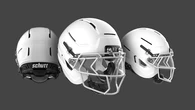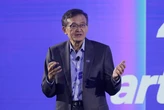On a hot, oppressively muggy summer day in a city like New York or Atlanta, when you crank up the AC, it might not feel like it’s working well. That’s because conventional air conditioners aren’t optimized to deal with humidity. Your AC will run longer as it tries to deal with both heat and moisture in the air—and if the humidity stays too high, your home can feel clammy or sticky even if the temperature is dropping. Because humidity makes the air feel hotter, you might not feel much cooler even as your electric bill climbs.
But what if you could save 90% of the cost of your air-conditioning electric bills—and actually be cool during a sweltering summer? That’s the promise of a new kind of AC technology that deals with humidity more effectively; it’s just coming out of testing and into commercial development. Though the technology exists, you’re going to have to wait (but not too long) before you can have it in your home.
The innovations, from a handful of startups and larger companies, can save huge amounts of energy and provide more effective temperature control. As the planet gets both hotter and more humid, new tech can help more people afford to stay cool. It also can help the grid so blackouts are less likely in a heat wave. And with less energy use, it can help tackle the cooling paradox: the fact that the growth of conventional air-conditioning is a major source of emissions, forcing us to rely on ACs even more.
The problem with legacy AC
New technologies take different approaches to solving the same challenge. “The air-conditioning problem really is a humidity control problem,” says Russ Wilcox, CEO of Trellis Air, an air-conditioning startup spinning out tech that was originally developed by Harvard researchers.
Standard air conditioners remove humidity and cool the air at the same time. When hot, wet air passes over cold coils inside the machine, it condenses, like beads of water on a cold drink. But because the system’s main goal is to cool, on a very humid day, you need to turn the temperature way down to remove enough humidity to try to feel comfortable.
The AC has to run longer, guzzling more energy. Rooms can end up either cool and clammy or too cold. In some large spaces, like a movie theater, overcooling sometimes means that the heat comes back on, despite the fact that it’s sweltering outside.
There are more than a billion air conditioners in use now, responsible for a carbon footprint that’s around twice as large as that of aviation, and around a third of the electricity they use is for dehumidification. Emissions are also quickly growing as more people buy air conditioners. By 2050, the number of units in use around the world is expected to triple, causing emissions from air-conditioning to potentially double to 2 billion tons of CO2 per year.
How the new tech works
Cutting-edge AC tech deals with humidity separately from temperature. Trellis, for example, uses a membrane to filter water vapor out of the air before cooling it, an approach that is far more efficient than a typical air conditioner that expends energy cooling both the air and the water inside it.
“That gives us a huge edge in energy for dehumidification,” Wilcox says. “And we do it with an engineered plastic film, which means it’s a pretty passive, simple, reliable, potentially very cost-effective way of dehumidifying.”
Blue Frontier, a startup that has raised more than $36 million from investors including Bill Gates’s Breakthrough Energy Ventures, uses a salt-based desiccant to store energy that can later be used when electricity prices are high. During peak hours, the system uses the desiccant to remove humidity. (It’s like a battery, but instead of storing electricity it stores drying power.) The technology can reduce electricity use by 50% to 90%.
Transaera, which raised an $8.2 million round of seed funding in November 2024, uses a type of material called a metal-organic framework (or “MOF”) with a microscopic tinker-toy-like shape.
MOFs are “really powerful because they allow us to target a specific molecule—you make the pores just the right size for that molecule to go in,” says Ross Bonner, cofounder and CTO of the Massachusetts-based startup. “In our case, we have tuned them for water.” Transaera uses the material to coat a substrate, and then can add it to a standard air conditioner. Depending on the climate, it can cut energy use by around 40%.
AirJoule, another startup, uses metal-organic frameworks along with waste heat to efficiently dehumidify and cool the air (and to produce pure water that can be used elsewhere). Data centers are target customers. Industry veteran Carrier has partnered with the startup to incorporate the tech into its own equipment.
Two large AC manufacturers, China’s Gree and Japan’s Daikin, have developed super-efficient air conditioners that use different sensors and controls for humidity and temperature.
“It’s really smart design and smart controls, and the ability to sense and respond to real-time conditions, that enables them,” says Ankit Kalanki, who works on the carbon-free buildings program at the nonprofit RMI. The designs from Gree and Daikin also use the most efficient components possible, from heat exchangers to compressors. Both companies won the Global Cooling Prize, a contest that launched in 2018 to encourage innovation in air conditioner design.
Proven tech
Over the past few years, the companies have been proving that the technology works. RMI recently partnered with Gree and Daikin to test their units in real-world conditions in India. They rented seven apartments in a city outside Mumbai and pitted the new designs against the most efficient ACs and mini-splits currently on the Indian market, looking at how much power it took to stay below 80 degrees Fahrenheit and 60% humidity.
Earlier this year, after nine months of testing under different weather conditions, they published the results: The new tech cut energy use by 60%.
Transaera began testing a prototype of its tech on a large commercial building in Houston last year. “Our approach was, okay, we have this technology, we’ve proven it out in the lab, we want to put it through its paces and really see if it can perform and do what we say it can do,” says Bonner. “So we found the most punishing climate that we’ve been in.”
Last summer, when they went on the roof of the building for the installation, they measured the surface temperature: 140 degrees. It was so hot that the installers had to wear knee pads so they didn’t burn themselves. After months of testing in Houston’s ultra-humid weather, where a typical summer day might have a heat index of 110 degrees, the AC has been saving even more energy than projected. Now Transaera is working with a manufacturer to make a full-size prototype for testing.
The path to market
If you need a new window air conditioner, you can’t yet go to the store and buy one of the new designs. So far, the first product to come to market is a commercial one. Blue Frontier launched a 15-ton “dedicated outdoor air system” (or DOAS) unit earlier this year.
Selling first to commercial customers—from medical centers to schools to restaurants—means that the company can have the biggest climate benefit with each unit it sells. “The conventional technology DOAS are the ‘gas guzzlers’ of the industry,” says Daniel Betts, founder and CEO of Blue Frontier. The standard tech of this type is very inefficient and energy-intensive. Blue Frontier’s version also offers energy storage so the units can run for four to six hours with little electricity use; that lets building owners make better use of renewable electricity and lower electric rates at certain times of day.
The technology can also be used in smaller residential units, but that will come later. “It’s just a matter of picking a market entry strategy that makes sense to us and that helps our community the most,” Betts says.
Gree and Daikin, the Global Cooling Prize winners, initially aimed to bring products to market in 2025. Their technology is ready, says RMI’s Kalanki, who is working with the companies on commercialization. But it isn’t likely that the ACs will be in stores this year. “From a technical feasibility standpoint, I think that has been proven through the testing,” he says. “So it’s more about commercial viability now.”
One challenge, Kalanki says, is that international standards for residential air conditioners don’t yet measure the energy used to remove humidity. “We’re working very closely with the international standards organization to really bring dehumidification into the conversation,” he says. “This needs to get reflected so we can reward the products in the right way and industry has the right target to design for.”
Though customers will be able to save money over time on electric bills, the up-front cost of the units will be higher, making them a little more challenging to sell. Institutional buyers, who purchase in bulk, could help jump-start the market, Kalanki says, noting, “That demand signal is going to be very critical for manufacturers to make those early investments.”
More commercial options are likely to be available sooner. AirJoule plans to be on the market next year. Transaera is now working with a manufacturer that will be able to produce its commercial units at scale after the current pilots end, and is already in conversations with customers. The technology has the biggest advantage against conventional products in a commercial application, Bonner says, but the company also plans to later make residential ACs. (It’s already made a viable prototype.)
Trellis, which launched last year, is at an earlier stage and hasn’t yet started testing prototypes. The process will take time. “I think we have a lot of ambition of how we can manufacture this cost-effectively in the supply chain and make a robust product,” says Wilcox, noting that the team previously worked together on the development of the screen for the Amazon Kindle. “But we also appreciate that it takes some years to really make something robust enough to ship all around the world.”
The startups recognize the urgency of their work, as the need for ACs and their impact continues to grow. “I’m always impatient,” says Bonner. “We can go faster, and we need to go faster. And we have a responsibility to future generations to make the difference that we know we need to.”








No comments